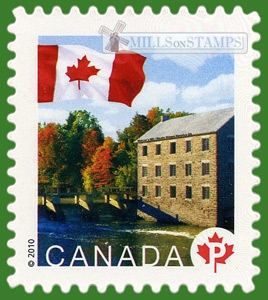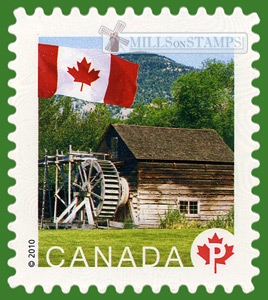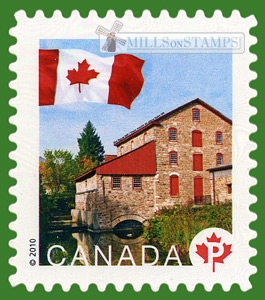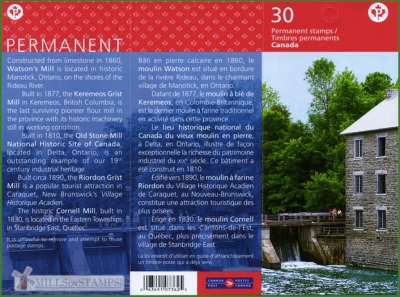-
Definitive issue. Flags over historic mills
Canada 2010.01.11
In issue: Stamp(s): 5 Souvenir sheet(s): 1 Booklet(s): 2
Issued in: self-adhesive booklets of 10 and 30 stamps (2 and 6 sets)
-
Perforation type: 13 ½x13 ½
Subject:
All stamps have a value for mail sending over Canada - "P" - 57 cents.
Watson’s Mill in Manotick, Ontario
Additional:
*Manotick, is a exurb in Eastern Ontario on the Rideau River, located on the south edge of Ottawa's urban area.
In the 1830s, a small settlement formed in the area of the newly constructed Long Island locks on the Rideau Canal, but no development was done in the area of present day Manotick. In 1858, when a bulkhead was constructed across the west branch of the Rideau River in the location of present day Manotick, entrepreneur Moss Kent Dickinson and his partner Joseph Merrill Currier obtained the water rights and constructed a mill. It was Dickinson, who in 1864 named the new village "Manotick," after the Ojibwa word meaning "island in the river". Mills established by Dickinson and Currier helped spur the development of the settlement. One of these, Watson's Mill, survives today (open to the public). As commercial traffic on the Rideau became less important, the population in the village declined. The population in the village rebounded as Manotick came to be viewed by some as a bedroom community for Ottawa, joining the City of Ottawa in 2001.
Watson's Mill is a historic gristmill. It was built as the Long Island Flouring Mills by Moss Kent Dickinson and Joseph Merrill Currier. It was one of a series of mills constructed in the area using power from the Rideau Canal. It earned its current name when it was purchased by Harry Watson in 1946. The mill remained in operation until 1972 when it was sold to the Rideau Valley Conservation Authority. They restored the mill to its 1860 condition and turned it into a museum and gift shop. It is Manotick's most notable landmark, and the mill's image is used as a symbol for the village. The mill is also well known for stories of it being haunted by the ghost of Annie Currier, wife of Joseph, who died in an accident there in 1861.
________
This information has been taken from Wikipedia
Topics: Watermills
-
Perforation type: 13 ½x13 ½
Subject:
Keremeos Grist Mill* in British Columbia
Additional:
*The Grist Mill at Keremeos in a Living, Working Museum
When Barrington Price built his flour mill in 1877, he probably never imagined it would be operating again in the 21st Century! In his time, it was equipped with some of the best milling equipment available, including a James Jones New Process roller mill and a Barford & Perkins grinder. It was state-of-the-art technology in the 1880s, and now it's the last example of a pioneer British Columbia mill that still has its historic, original machinery and building in place.
It took years of painstaking research to re-assemble and restore the operating layout to its 1881 configuration. When the restoration of the mill began in the 1980s, the old machines and parts were found in a jumble on the lower level - with Price's Eureka Grain Cleaner actually holding up the sagging second floor! Careful analysis of every nail hole and wear mark inside the building has enabled the original position of each machine and pulley frame to be identified or calculated.
Now a working waterwheel and flume provide power to the inner workings of the mill, and in Price's old store, now a museum of unique hands-on exhibits, you'll be able to operate various devices that demonstrate the principles involved in 19th Century flour milling.
The sunny Similkameen area of Southern British Columbia's interior, close to the Canadian and United States border, is famous for the quality of products from its orchard industry. The Grist Mill has an heirloom apple orchard and a small plot of heritage wheat growing on the upper fields, and some of the most interesting organically-managed heritage gardens in Canada.________
This information has been taken from British Columbia web pageSee also the stamped card for this stamp
Topics: Watermills
-
Perforation type: 13 ½x13 ½
Subject:
Old Stone mill National Historic Site of Canada*
Additional:
*The Old Stone Mill National Historic Site has been designated by the Government of Canada as a place of national historic significance. This place is part of the Family of National Historic Sites, one of more than 800 places across Canada which help define the important aspects of Canada's diverse but common heritage and identity. Further information on the National Historic Sites Program can be found at the Parks Canada website.
The Old Stone Mill is the oldest surviving automatic stone grist mill in Ontario. Now we need your help - a major fund-raising effort is now underway to restore the mill to operational condition in time for its 200th anniversary in 2010.
A self-guided tour of the mill features interpretive displays, a full size breast wheel waterwheel, and artifacts illustrating the grist milling process through the years. Artifacts include buhr millstones, 48-inch Swain turbines, roller mills and much more.
In the Museum of Industrial Technology, the former Old Town Hall (just around the corner from the mill), the exhibits highlight some of the early industries of the region including early agricultural equipment.________
This information has been taken from National Historic Site of Canada web page
See also the stamped card for this stamp
Topics: Watermills
-
Perforation type: 13 ½x13 ½
Subject:
Riordon Grist Mill*
Additional:
*Riordon grist mill at the Village Historique Acadien (VHA) near Caraquet was unveiled today by Canada Post at the VHA site.
The Riordon Mill was destroyed by fire in 1888, rebuilt and opened around 1890. It consisted of a sawmill, grist mill, and wool-carding mill, all operated by hydraulic power. The grist mill ceased operations in 1914 because of a dispute between Thomas Riordon and a company that repaired rollers for crushing grain.
When the decision was made to transport the Riordon Mill to the VHA site, it was in bad condition. The VHA team managed to save 80 per cent of the structure and machinery. After the grist mill was restored, it opened to the public in the early 1980s. Major repairs were also made in 2009 to preserve the building.________
This information has been taken from New Brunswick web page
See also the stamped card for this stamp
Topics: Watermills
-
Perforation type: 13 ½x13 ½
Subject:
Cornell Mill*, Eastern Townships in Stanbridge East, Quebec
Additional:
*First settled by New Englanders in 1801, Stanbridge East developed into a farming and industrial center. By the 1830s, Stanbridge had a post office, bank, tannery, brick works, foundry and a grist mill.
Early settlers harnessed the Pike River to grind their cornmeal and buckwheat into flour. Today the Cornell Mill (1830) is home to the Missisquoi Museum, which contains one of Quebec’s best rural heritage and archival collections. The mill is part of a museum complex that includes Hodge’s Store and Bill’s Barn, where antique farm machinery is exhibited.
________This information has been taken from Quebec Heritage Web
See also the stamped card for this stamp
Topics: Watermills
-
Perforation type: 13 ½x13 ½
Subject:
On the back of the booklet contains the description of mills in English and French.
Size (of sheet, booklet) mm: 134x55
Topics: Watermills
-
Perforation type: 13 ½x13 ½
Subject:
On the back of the booklet contains the description of mills in English and French and decorated by big photo of Watson's Mill.
Size (of sheet, booklet) mm: 179x134
Topics: Watermills
-
Perforation type: 13 ½x13 ½
Subject:
On the souvenir sheet design five stamps of a series and the image of Esterhazy flour mill* have been used.
Additional:
*A plaque commemorating the Esterhazy Flour Mill as a Provincial Heritage Property was officially unveiled on July 30, 2005. Construction of the mill was completed in 1907 and the mill operated until the 1980s, making the Esterhazy Flour mill the oldest and most complete mill of heavy post and beam construction in Saskatchewan. The Esterhazy Flour Mill was designated a Provincial Heritage Property earlier in the year; however, the plaque was unveiled to coincide with Esterhazy's centennial homecoming.
After remarks from Esterhazy Mayor Merv Cushman, Judy Parker, Economic Development Officer for Esterhazy, and Bob Bjornerud, MLA Melville-Saltcoats, recognizing the value of the property to the community and the province, visitors were invited to take guided tours of the mill. During the Esterhazy homecoming weekend, more than 300 people visited the site.
Ralph May, with Friends of the Esterhazy Flour Mill (a group instrumental in maintaining and fixing the mill) spoke to what provincial designation meant to the community, saying that the Provincial Heritage Property designation of the Esterhazy Flour Mill will bring recognition and raise awareness of both the property and the community.This information has been taken from Government of Saskatchewan web page.
________
Please, look at the FDC for this issue
Size (of sheet, booklet) mm: 130x70
Topics: Industrial mills Watermills









